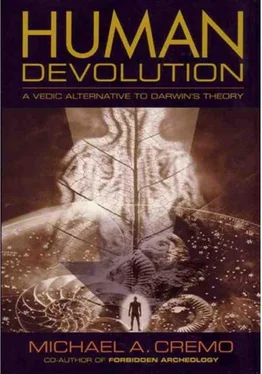Michael Cremo - Human Devolution - A Vedic Alternative To Darwin's Theory
Здесь есть возможность читать онлайн «Michael Cremo - Human Devolution - A Vedic Alternative To Darwin's Theory» весь текст электронной книги совершенно бесплатно (целиком полную версию без сокращений). В некоторых случаях можно слушать аудио, скачать через торрент в формате fb2 и присутствует краткое содержание. Год выпуска: 2003, ISBN: 2003, Издательство: Torchlight Publishing, Жанр: Старинная литература, на английском языке. Описание произведения, (предисловие) а так же отзывы посетителей доступны на портале библиотеки ЛибКат.
- Название:Human Devolution: A Vedic Alternative To Darwin's Theory
- Автор:
- Издательство:Torchlight Publishing
- Жанр:
- Год:2003
- ISBN:9780892133345
- Рейтинг книги:4 / 5. Голосов: 1
-
Избранное:Добавить в избранное
- Отзывы:
-
Ваша оценка:
- 80
- 1
- 2
- 3
- 4
- 5
Human Devolution: A Vedic Alternative To Darwin's Theory: краткое содержание, описание и аннотация
Предлагаем к чтению аннотацию, описание, краткое содержание или предисловие (зависит от того, что написал сам автор книги «Human Devolution: A Vedic Alternative To Darwin's Theory»). Если вы не нашли необходимую информацию о книге — напишите в комментариях, мы постараемся отыскать её.
Human Devolution: A Vedic Alternative To Darwin's Theory — читать онлайн бесплатно полную книгу (весь текст) целиком
Ниже представлен текст книги, разбитый по страницам. Система сохранения места последней прочитанной страницы, позволяет с удобством читать онлайн бесплатно книгу «Human Devolution: A Vedic Alternative To Darwin's Theory», без необходимости каждый раз заново искать на чём Вы остановились. Поставьте закладку, и сможете в любой момент перейти на страницу, на которой закончили чтение.
Интервал:
Закладка:
On another occasion, Wallace observed a similar occurrence: “A stick was pushed out through the curtain. Two watches were handed to me through the curtain, and were claimed by the two persons who sat by the medium. The small tambourine, about ten inches in diameter, was pushed through the curtain and fell on the floor. These objects came through different parts of the curtain, but left no holes as could be seen at the time, and was proved by a close examination afterwards. More marvellous still (if that be possible), a waistcoat was handed to me over the curtain, which proved to be the medium’s, though his coat was left on and his hands had been held by his companions all the time; also about a score of people were looking on all the time in a well-lighted room. These things seem impossible, but they are, nevertheless, facts” (Wallace 1905, v. 2, pp. 344–345).
In San Francisco, Wallace, along with his brother John, who lived in California, and Mr. Owen, editor of the Golden Gate , attended some slate writing sessions with the medium Fred Evans (Wallace 1905, v. 2, pp. 346–349). A physician, a friend of Mr. Owen, also was present. Four folding slates were cleaned with a damp sponge and then handed to the four guests for inspection. The slates were closed and placed on the table. The guests then placed their hands on the slates. When a signal was given, they opened the slates and found writing on all of them. The messages were from departed relatives of Wallace and departed spiritualists. The usual skeptical explanation is that the slates were somehow switched. But Wallace’s description of the procedure appears to rule that out, as the witnesses had their own hands on the slates at critical times.
Another set of slates was set on the table. The medium marked one of these slates with a pencil. When opened, this slate was covered with writing in five colors. Wallace observed that the letters were clearly superimposed over the pencil marks. This appears to rule out any clever chemical means of producing the letters.
Wallace’s brother had brought a new folding slate of his own. This was placed nearby on the floor for a few minutes. Wallace kept the slate in sight the entire time. When the slate was opened, a message was found written upon both sides of it. That it was a new slate, not belonging to the medium, is significant.
Wallace then asked the medium if the writing could be produced on pieces of paper placed between slates. Evans told Wallace to take six pieces of paper from a notepad and place them between a pair of slates. Wallace did so. After a few minutes, the slates were opened. Wallace found portraits of five departed spiritualists and a long dead sister of his drawn in crayon on the six pieces of paper, which had rested one on top of the other between the slates. They had been placed there by Wallace himself, ruling out substitution by the medium. Given the unexpected request by Wallace, the circumstances under which the pieces of paper were placed between the slates, it is hard to see how the medium could have carried out any deception.
Wallace (1905 v. 2, pp. 348–349) noted: “The whole of the seven slates and six papers were produced so rapidly that the séance occupied less than an hour, and with such simple and complete openness, under the eyes of four observers, as to constitute absolutely test conditions. . . . A statement to this effect was published, with an account of the séance , signed by all present.”
Wallace’s theory of Spiritualism: Analysis and Critique
Summarizing the conclusions he drew from his spiritual researches, Wallace (1892, p. 648) stated: “The universal teaching of modern spiritualism is that the world and the whole material universe exist for the purpose of developing spiritual beings—that death is simply a transition from material existence to the first grade of spirit-life—and that our happiness and the degree of our progress will be wholly dependent upon the use we have made of our faculties and opportunities here.”
Such conclusions were drawn solely from facts that had been carefully and repeatedly observed in nature, and they were thus entirely scientific, said Wallace (Wallace 1885a, p. 809). The observable facts did not, however, warrant extending spiritualist conclusions beyond certain limits. The verifiable facts of spiritualism were, according to Wallace, related to humans and the spirit beings nearest to earthly human existence. He therefore warned: “Speculations on the nature or origin of mind in general as well as those on the ultimate states to which human minds may attain in the infinite future, I look upon as altogether beyond the range of our faculties, and to be, therefore, utterly untrustworthy and profitless” (Wallace 1885b; in Smith 1991, p. 101). Wallace was generally content with the limited conclusions that could be drawn from the observable middle ground of human experience. He himself did, however, sometimes venture into the realm of “untrustworthy” speculation about origins and ultimate states.
Wallace found spiritualism to be a good scientific hypothesis, for it allowed him to intelligibly organize and explain many categories of evidence. For example, spiritualism allowed him to accommodate in one explanatory system the spiritlike daimon that advised Socrates, the Greek oracles, the miracles of the Old and New Testaments, the miracles of saints such as St. Bernard, St. Francis, and St. Theresa; the phenomena of witchcraft; modern Catholic miracles such as Marian apparitions; psychic powers reported in primitive peoples, and the efficacy of prayer, as well as the phenomena of modern spiritualism (Wallace 1874; in Smith 1991, pp. 87–89). All of these could be attributed to spirits acting through especially sensitive humans to produce unusual physical and mental effects.
If spirits were nonmaterial or made of “the most diffused and subtle forms of matter,” (Wallace 1896, p. 44) how could they act on, or even produce, substantial material objects? Wallace observed that “all the most powerful and universal forces of nature are now referred to minute vibrations of an almost infinitely attenuated form of matter; and that, by the grandest generalisations of modern science, the most varied natural phenomena have been traced back to these recondite forces” (Wallace 1896, p. 44). Regarding the “almost infinitely attenuated form of matter,” Wallace was referring to a space-filling ether. In his system, the spirit beings would act on the ether, and this subtle action would amplify through the forces of nature into action on the level of observable matter.
Wallace (1896, pp. 47–48) further proposed: “Beings of an ethereal order, if such exist, would probably possess some sense or senses . . . giving them increased insight into the constitution of the universe, and proportionately increased intelligence to guide and direct for special ends those new modes of ethereal motion with which they would in that case be able to deal. Their every faculty might be proportionate to the modes of action of the ether. They might have a power of motion as rapid as that of light or the electric current. They might have a power of vision as acute as that of our most powerful telescopes and microscopes. They might have a sense somewhat analogous to the powers of the last triumph of science, the spectroscope, and by it be enabled to perceive instantaneously, the intimate constitution of matter under every form, whether in organised beings or in stars and nebulae. Such existences, possessed of such, to us, inconceivable powers, would not be supernatural, except in a very limited and incorrect sense of the term . . . all would still be natural.”
The space-filling ether of nineteenth century physics is no longer with us. But there are modern scientific concepts that would allow Wallace’s basic system to operate. According to deterministic chaos theorists, immeasurably small random perturbances of matter can rapidly propagate into large-scale effects that are not easily predictable. Scientists sometimes give the example of a Caribbean butterfly that by its wings sets off motions of air molecules. These movements might eventually amplify to steer a hurricane from open sea into the American coast. If the butterfly had flapped its wings slightly differently, the hurricane might not have hit land. According to this idea, Wallace’s spirit beings might make infinitesimal adjustments on the subatomic level that would quickly propagate into observable spiritualist effects. One might also propose that they are somehow capable of manipulating the curvature of Einstein’s space-time continuum. They could thus produce gravitational effects, for gravity is said to be the result of curvature in the continuum. Or one might propose that the spirit beings induce slight changes in the quantum mechanical vacuum, which in some ways resembles an ether. Of course, this approach is limiting, and rather than straining to find ways to explain spiritualist phenomena in conformity with currently accepted physical laws, it may make more sense to come up with a new theoretical system that more naturally incorporates both the normal and paranormal phenomena. Reintroducing a variety of the ether concept might be one way to do it. One could define the ether as a subtle interface between consciousness and matter.
Читать дальшеИнтервал:
Закладка:
Похожие книги на «Human Devolution: A Vedic Alternative To Darwin's Theory»
Представляем Вашему вниманию похожие книги на «Human Devolution: A Vedic Alternative To Darwin's Theory» списком для выбора. Мы отобрали схожую по названию и смыслу литературу в надежде предоставить читателям больше вариантов отыскать новые, интересные, ещё непрочитанные произведения.
Обсуждение, отзывы о книге «Human Devolution: A Vedic Alternative To Darwin's Theory» и просто собственные мнения читателей. Оставьте ваши комментарии, напишите, что Вы думаете о произведении, его смысле или главных героях. Укажите что конкретно понравилось, а что нет, и почему Вы так считаете.












